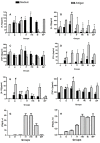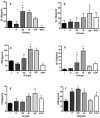Immunomodulation From Moderate Exercise Promotes Control of Experimental Cutaneous Leishmaniasis
- PMID: 31131262
- PMCID: PMC6510011
- DOI: 10.3389/fcimb.2019.00115
Immunomodulation From Moderate Exercise Promotes Control of Experimental Cutaneous Leishmaniasis
Abstract
Physical exercise has been described as an important tool in the prevention and treatment of numerous diseases as it promotes a range of responses and adaptations in several biological systems, including the immune system. Studies on the effect of exercise on the immune system could play a critical role in improving public health. Current literature suggests that moderate intensity exercise can modulate the Th1/Th2 dichotomy directing the immune system to a Th1 cellular immune response, which favors the resolution of infections caused by intracellular microorganisms. Leishmaniasis is a group of diseases presenting a wide spectrum of clinical manifestations that range from self-limiting lesions to visceral injuries whose severity can lead to death. The etiological agents responsible for this group of diseases are protozoa of the genus Leishmania. Infections by the parasite Leishmania major in mice (Balb/c) provide a prototype model for the polarization of CD4+ T cell responses of both Th1 (resistance) or Th2 (susceptibility), which determines the progression of infections. The aim of this study was to evaluate the effect of exercise on the development of L. major experimental infections by scanning the pattern of immune response caused by exercise. Groups of Balb/c mice infected with L. major were divided into groups that preformed a physical exercise of swimming three times a week or were sedentary along with treatment or not with the reference drug, meglumine antimoniate. Animals in groups submitted to physical exercise did not appear to develop lesions and presented a significantly lower parasite load independent of drug treatment. They also showed a positive delayed hypersensitivity response to a specific Leishmania antigen compared to control animals. The IFN-γ/IL-4 and IFN-γ/IL10 ratios in trained animals were clearly tilted to a Th1 response in lymph node cells. These data suggest that moderate intensity exercise is able to modulate the Th1 response that provides a protective effect against the development of leishmanial lesions.
Keywords: Balb/c; control of infection; exercise; immune response; leishmaniasis.
Figures






Similar articles
-
Anti-leishmania effector functions of CD4+ Th1 cells and early events instructing Th2 cell development and susceptibility to Leishmania major in BALB/c mice.Adv Exp Med Biol. 1998;452:53-60. doi: 10.1007/978-1-4615-5355-7_7. Adv Exp Med Biol. 1998. PMID: 9889959 Review.
-
Nonhealing infection despite Th1 polarization produced by a strain of Leishmania major in C57BL/6 mice.J Immunol. 2005 Mar 1;174(5):2934-41. doi: 10.4049/jimmunol.174.5.2934. J Immunol. 2005. PMID: 15728505
-
Transgenic expression of CXCR3 on T cells enhances susceptibility to cutaneous Leishmania major infection by inhibiting monocyte maturation and promoting a Th2 response.Infect Immun. 2015 Jan;83(1):67-76. doi: 10.1128/IAI.02540-14. Epub 2014 Oct 13. Infect Immun. 2015. PMID: 25312956 Free PMC article.
-
Repeated intravenous injection of adipose tissue derived mesenchymal stem cells enhances Th1 immune responses in Leishmania major-infected BALB/c mice.Immunol Lett. 2019 Dec;216:97-105. doi: 10.1016/j.imlet.2019.10.008. Epub 2019 Oct 14. Immunol Lett. 2019. PMID: 31622634
-
Distinct immunological states in murine cutaneous leishmaniasis by immunising with different amounts of antigen: the generation of beneficial, potentially harmful, harmful and potentially extremely harmful states.Behring Inst Mitt. 1997 Feb;(98):153-9. Behring Inst Mitt. 1997. PMID: 9382736 Review.
Cited by
-
Physical Activity of ≥7.5 MET-h/Week Is Significantly Associated with a Decreased Risk of Cervical Neoplasia.Healthcare (Basel). 2020 Aug 10;8(3):260. doi: 10.3390/healthcare8030260. Healthcare (Basel). 2020. PMID: 32785028 Free PMC article.
-
Chronic Aerobic Training at Different Volumes in the Modulation of Macrophage Function and in vivo Infection of BALB/c Mice by Leishmania major.Front Microbiol. 2021 Sep 20;12:734355. doi: 10.3389/fmicb.2021.734355. eCollection 2021. Front Microbiol. 2021. PMID: 34616386 Free PMC article.
-
How to Exercise During Coronavirus Quarantine?Caspian J Intern Med. 2020 Fall;11(Suppl 1):479-483. doi: 10.22088/cjim.11.0.479. Caspian J Intern Med. 2020. PMID: 33425264 Free PMC article. Review.
References
-
- ACSM (2011). American College of Sports Medicine position stand. Quantity and quality of exercise for developing and maintaining cardiorespiratory, musculoskeletal, and neuromotor fitness in apparently healthy adults: guidance for prescribing exercise. Med. Sci. Sports Exerc. 43, 1334–1359. 10.1249/MSS.0b013e318213fefb - DOI - PubMed
-
- American College of Sports Medicine Position Stand and American Heart Association - ACSM/AHA. (1998). Recommendations for cardiovascular screening, staffing, and emergency policies at health/fitness facilities. Med. Sci. Sports. Exerc. 30, 1009–1018. - PubMed
Publication types
MeSH terms
Substances
LinkOut - more resources
Full Text Sources
Research Materials

